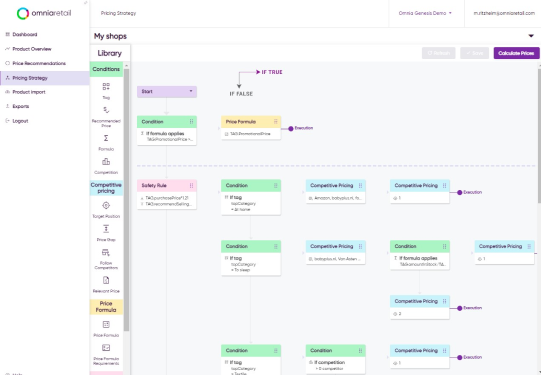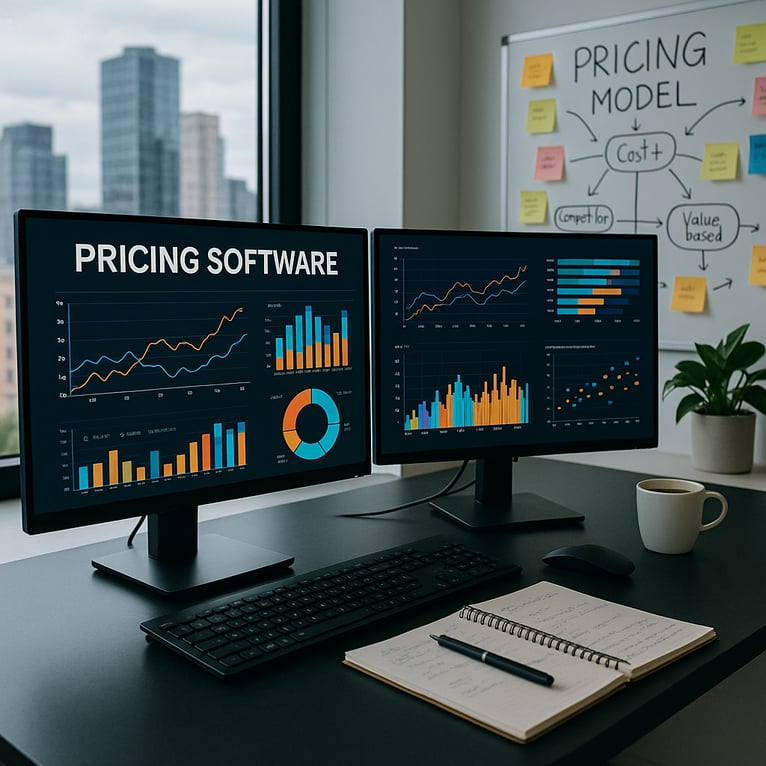Modern-day pricing is so much more than a numbers game. When thought about correctly, it’s a powerful way to build your brand and drive more profits.
But how do you access the full power of pricing? The key is to understand the psychology that goes into a pricing strategy, and this article is a perfect place to start.
To continue our series of articles about different pricing strategies, in this article, we’ll discuss what psychological pricing is, how it works, and what you need to build a great psychological pricing strategy.
What is Psychological Pricing?
Psychological pricing is a strategy that uses pricing tactics to appeal to consumers' emotional responses rather than their rational evaluation. It leverages cognitive biases to influence purchasing decisions by presenting prices in ways that make products seem more attractive or valuable.
Key Characteristics of Psychological Pricing
- Focuses on perception rather than the actual numerical value
- Appeals to emotional rather than logical decision-making
- Uses specific price points to create particular impressions
- Influences consumer behavior through subtle price presentation
As pricing becomes increasingly strategic in competitive e-commerce, understanding how consumers think, not just what they buy, is critical. Psychological pricing sits at the intersection of behavioral economics and marketing, giving brands a unique edge.
Why Psychological Pricing Works
To understand why psychological pricing works, we need a quick lesson in marketing and pricing psychology. Take a look at Maslow’s hierarchy of needs, which is a theory of how humans prioritize different things in their lives. At the bottom of the pyramid are physiological needs - you know, the things we as humans truly need for continued survival. These include food, water, shelter, rest, oxygen, etc.

Once basic survival needs are met, people focus on safety, then belonging and community, followed by self-esteem, and finally self-actualisation at the top of Maslow’s hierarchy. If you work in e-commerce marketing, you’re likely familiar with this theory, which is foundational for understanding what motivates people beyond just purchasing.
Psychological pricing leverages this insight, guiding pricing, sales, and marketing teams to create strategies rooted in what truly drives human behavior. Effective psychological pricing begins with a deep understanding of these underlying needs, ensuring strategies aren’t just customer-focused, but people-focused.
Talk to Our Consultants About Dynamic Pricing

Examples of Psychological Pricing Strategies
They are everywhere and are employed by some of the top global companies like Amazon, Hershey, Motorola, Apple, and Costco. In this section, we’ll highlight a few examples of psychological pricing tactics, many of which we’ve already written about extensively on Omnia’s site.
1) Value-Based Pricing
Value-based pricing is a basic pricing strategy, but it’s one of the hardest to pull together because it requires an excellent understanding of the market and a lot of self-reflection. In a value-based pricing strategy, you use your price as a way to control consumer understanding of your product. Do you want to be seen as a luxury brand? Then you probably should have a luxury price. Do you want to come off as the best value-for-money option on the market? Well, your price should reflect that.
Value-based pricing requires a lot of research into your target market, competitive landscape, and business goals. That means a lot of cooperation across departments, but that cooperation is a great way to build a more cohesive strategy.
2) Odd-Even Pricing
Odd-even pricing is a psychological pricing tactic that uses the power of number psychology to drive consumers to action. The odds and the evens refer to the numbers in a price: “odd” retail prices feature mostly odd numbers (like €7.99), whereas “even” prices feature mostly even numbers (like €8.00).
Most often, we see prices that end in odd numbers, but even prices have their own psychological power. Odd-even pricing can be used strategically in several different ways, whether it’s to offer strategic discounts or just create a price that is memorable. Below is an example of how Uniqlo does exactly that - the company is discounting a shirt that originally cost €24.90 (a mostly “even” price) down to €7.90 (a more “odd” price).

3) Charm Pricing
Charm pricing plays on our tendency to perceive prices ending in .99, .95, or just-below-round-numbers as cheaper than they actually are. It’s a psychological shortcut, one that nudges consumers toward a purchase by making the price feel like a better deal.
This tactic is especially effective in price-sensitive markets or when launching new offers. For example, a D2C skincare brand introducing a product bundle might price it at €19.99 instead of €20.00, or use a bundled offer like “3 for €20” to reinforce the perception of value while increasing average order value.
It’s simple, intuitive, and surprisingly powerful, especially when combined with other pricing strategies like anchoring or discount framing.
Strategies for success:
3 Psychological Pricing Effects That Influence Buying Decisions
There are a number of ways to influence buying decisions and, under certain conditions, retailers can actually get consumers to spend more. Certain nudges and strategies, which are simple and easy to implement in nature, are referred to by Dan Thwaites and Patrick Fagan, co-founders of Capuchin Behavioural Science, who shared their knowledge with Omnia Retail’s customers at Price Points Live 2022.
The Decoy Effect
This is a technique used by retailers to push consumers toward two product options that are similar in value (such as a microwave) by introducing a third one as a decoy that is much more expensive. Adding a decoy is considered “a violation of rationality” by introducing cognitive bias against it. Consumers are pushed toward the other two options without even knowing it.
Retailers can test this by adding a third “decoy” SKU next to high- and mid-tier products. Here is an example:
Academic Dan Ariely shared in his book "Predictably Irrational" a study he did to show how well the decoy effect works. In his experiment, he presented three options for subscriptions to his students to choose from:
1) Online-only access for $59.00 a year
2) Print-only access for $125.00 a year (the decoy)
3) Online and print access for $125.00 a year
16% of the students chose the first option, none chose the second option, and 84% chose the third option. Ariely then removed the decoy option. Even though no one selected the second option in his earlier experiment, this time with only two options, the results showed a considerable shift. When given only two options, 68% of the students chose the online-only access for $59.00 a year, and only 32% chose the online and print access option for $125 a year.
How Philips Implemented Dynamic Pricing With Omnia

The Anchoring Effect
Consumers often anchor their perceptions to the first price or detail they encounter, even if it’s unrelated or arbitrary. This anchoring effect can strongly influence which product, brand, or price they perceive as the best option. As a result, your initial price presentation becomes an important tool for shaping value perception and guiding purchasing decisions.
For example, if a retailer were conducting research and asked how much a consumer would pay for a smoothie that had collagen production ingredients in it, the only information the consumer would have to go on is their previous experience with buying smoothies, because they wouldn’t know what the cost is for collagen-inducing ingredients. Or, perhaps a retailer wants to push sales for a new waffle-making machine, and it is marketed as having cutting-edge technology for perfectly shaped waffles with new mechanics to prevent spills or messes. Consumers may latch onto the idea of something being “new and improved” versus previous experiences with older machines.
The Precision Effect
Surprisingly, non-rounded prices (like €19.55) can feel more precise, and sometimes cheaper, than round prices (like €20.00). This counterintuitive insight is at the core of what's known as the Precision Effect.
A number of studies and papers have been written about this theory, including“The Price Precision Effect: Evidence from Laboratory and Market Data”. The data in this paper shows that rounded prices (like €20.00) often feel more expensive or inflated than non-rounded ones (like €25.55), even when the actual amount is higher. That's because precise prices feel more calculated and trustworthy, while round numbers may feel arbitrary or overly commercial.
In practice, this means pricing a product at €25.55 can sometimes feel like a better deal than €25.00. The effect even shows up in big-ticket categories like real estate, where buyers were more likely to spend more on homes listed with precise prices.
For retailers, using this tactic thoughtfully, especially on mid- to high-ticket items, can increase perceived fairness, boost credibility, and subtly guide purchasing decisions.
Nudging Consumers Means Understanding Buying Behaviour
In uncertain economic times, understanding how consumers think and behave becomes even more valuable. Shoppers are more price-conscious, more selective, and more influenced by subtle psychological cues.
For retailers and e-commerce teams, applying behavioral pricing strategies like decoys, anchoring, or price precision is a strategic move that can have a big impact. These small, science-backed adjustments can help build trust, strengthen perceived value, and drive growth even in tough market conditions.
Ultimately, the brands that thrive are the ones that listen closely to customer behavior and use these insights to price smarter.
Pros and Cons of Psychological Pricing
Psychological pricing strategies are extremely advantageous, but are also hard to set up. Here are a few of the pros and cons of these techniques.
Advantages of Psychological Pricing
- Get a better understanding of the playing field: When you aim to use a psychological pricing strategy, you need to do a lot of research into who your competitors are, what strategies they are using, and what your target audience thinks of those pricing strategies. This research gives you tons of insights that you can use across the organization.
- More organizational alignment: A psychological pricing strategy should never be carried out by an isolated pricing team. Instead, these strategies require serious cross-department commitments and communications.
- More strategic: With a psychological pricing strategy, you can actually be proactive in your strategy. Rather than just trying to maximize profits or break even, you can consider things like public perception of your products, competitor comparisons, and more.
Disadvantages of Psychological Pricing
- Complex: Psychological pricing strategies are complex. They require a lot of cross-organizational cooperation and insights. This makes them hard to set up and stick to.
- Time-consuming: Because psychological pricing strategies require in-depth research, they can be time-consuming to set up. If you invest in software (like Pricewatch or Omnia's Dynamic Pricing tool), the job becomes easier, but it still takes a lot of energy.
Final Thoughts
The term “psychological pricing” can cover any number of pricing strategies, several of which we’ve covered in this article. But there are no limits, in all honesty, any pricing strategy that uses consumer ideas about product value is inherently psychological, so feel free to be creative. What is most important, though, is internal alignment. Psychological pricing strategies work best when they align with marketing and sales to ensure a cohesive experience for the user across your webshop.
How will you make your pricing smarter from here? If you’re curious about how dynamic pricing could work for your business, we’d love to talk.
Schedule a call with our experts!
Read more about interesting pricing strategies here:
- What is Dynamic Pricing?: The ultimate guide to dynamic pricing.
- What are the best pricing strategies?: Read about 17 pricing strategies for you as a retailer or brand.
- What is Price Monitoring?: Check out everything you need to know about price comparison and price monitoring.
- What is Charm Pricing?: A short introduction to a fun pricing method.
- What is Penetration Pricing?: A guide on how to get noticed when first entering a new market.
- What is Bundle Pricing?: Learn more about the benefits of a bundle pricing strategy.
- What is Cost Plus Pricing?: In this article, we’ll cover cost-plus pricing and show you when it makes sense to use this strategy.
- What is Price Skimming?: Learn how price skimming can help you facilitate a higher return on early investments.
- What is Map Pricing?: Find out why MAP pricing is so important to many retailers.
Frequently Asked Questions
What is meant by psychological pricing?
What role does psychological pricing play in promotions and markdown strategies?
Is psychological pricing suitable for luxury or premium brands?
How can pricing managers test psychological pricing strategies without hurting margins?
Can psychological pricing be integrated into omnichannel strategies?
What Are the 4 Main Types of Pricing Strategies?
This approach sets prices based on the cost to produce and deliver the product, plus a markup. It's simple and ensures profit, but doesn’t account for market dynamics or consumer perception.
Value-Based Pricing
Prices are set based on the perceived value to the customer rather than the cost. This works well for differentiated or premium products and requires deep understanding of your target audience.
Competition-Based Pricing
Also called market-based pricing, this strategy sets prices in relation to competitors — slightly above, below, or matched — depending on positioning goals and price elasticity.
Dynamic Pricing
Prices change based on real-time variables like demand, inventory, time of day, or competitor activity. This is common in e-commerce, travel, and electronics, and increasingly driven by software.



.png?height=766&name=Untitled%20design%20(21).png)
